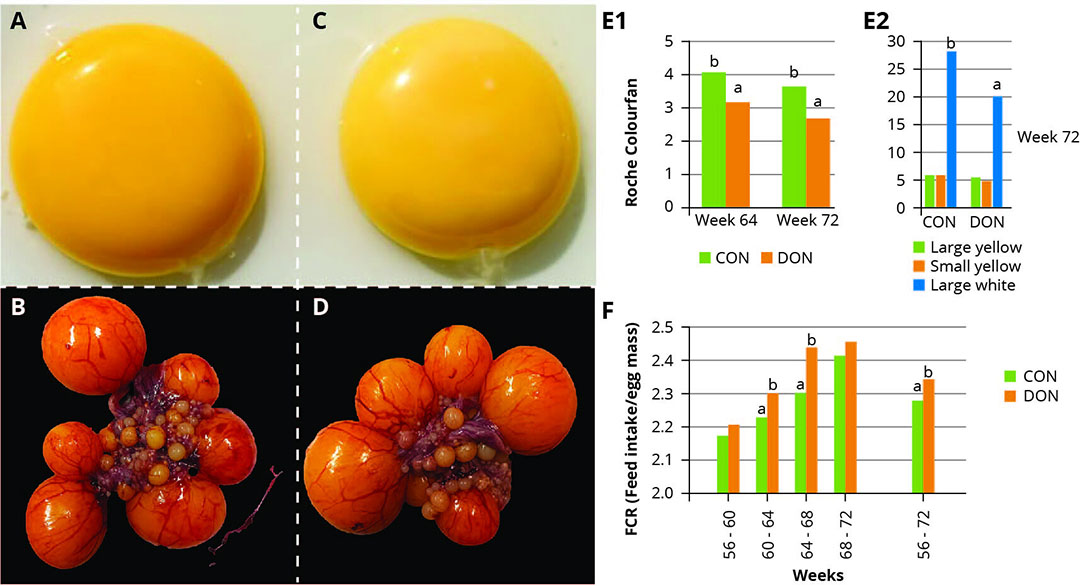Impact of moderate DON exposure on laying hen performance
Preliminary data show that moderate dietary exposure to deoxynivalenol has a detrimental influence on laying hen production performance.
The composition and quality of feed are crucial to the production performance, health and welfare of poultry. In addition to the advantageous elements included in a well-balanced diet, livestock’s feed frequently contains undesirable substances, such as mycotoxins.
Mycotoxins from fungi belonging to the Fusarium species have well-documented detrimental effects on the intestinal health of broiler chickens. It is important to note that the negative impact on both production performance and intestinal integrity can occur even at mycotoxin levels close to 1,800 ppb of deoxynivalenol (DON), resulting in new guidance of 600 ppb based on a recent opinion by the European Food Safety Authority (EFSA).
Lack of research
Due to the lack of sufficient research performed with laying hens, the recommended maximum DON levels in their diets remained at 5,000 ppb. Given the impact of DON on intestinal health, it’s reasonable to anticipate that exposure to this mycotoxin will also impact laying hens’ production performance and egg quality, as it may hinder optimal nutrient absorption.
While the laying hens are getting older, the laying rate tends to decrease, especially if the absorption of nutrients does not occur properly in the intestine. Under normal circumstances, this is also the period in which the first signs of decline in eggshell quality and ovarian function can be observed. Exposure to mycotoxins might enhance and speed up this process.
Research design
At SFR, we fed 600 56-week-old Dekalb White laying hens a marginally contaminated diet (control; CON) or a diet containing 2,400 ppb DON (DON) for a period of 16 weeks. The experiment had a randomised complete block design with 2 treatments and 6 replicates (i.e., pens). We prepared the DON-contaminated diet using a naturally contaminated corn batch, resulting in a multi-contaminated diet. However, DON was the predominant mycotoxin (Table 1).
Table 1 – Multi-mycotoxins analyses of the diets (levels in ppb).
Control diet: Prepared with marginally contaminated corn; DON diet: Prepared with the same basal mixture containing the DON-contaminated corn.
| Levels of mycotoxins in diets (ppb) | |||
| Mycotoxins | Control (CON) | Deoxynivalenol (DON) | |
| DON | – | 2,450.0 | |
| 3+15 Ac-DON | – | 66.2 | |
| DON-3-glucoside | 77.1 | 843.0 | |
| Zearalenone | – | 209.0 | |
| Fumonisins B1+B2 | – | 23.5 | |
| Beauvericin | 6.1 | 11.8 |
It is also important to point out that the control diet had some traces of mycotoxins (DON-3-glucoside, DON-3G, and beauvericin). The laying hens had ad libitum access to feed and fresh drinking water. Each replicate consisted of 50 hens in a pen. The diets were not supplemented with colourants.
During the 16-week trial some technical measurements were performed:
- Feed intake per pen was recorded weekly;
- Laying rate per pen, based on daily egg counting, was recorded per week;
- Egg weight and mass were recorded per pen weekly;
- Feed conversion ratio (FCR) was calculated weekly considering feed intake and egg mass.
At 64 and 72 weeks of age, eggs (10 per pen) were collected for quality analysis, including egg yolk colour. Furthermore, samples of the intestines, eggshell gland, and ovaries of laying hens were collected for integrity and function analyses.
Decrease in egg yolk colour
We share our initial findings, which are also summarised in Figure 1. There was a significant decrease in the egg yolk colour when the laying hens were fed the DON diet for 8 or 16 weeks, compared with control (panels A, C, and E1). The DON-contaminated diet contained fewer carotenoids than the control diet, suggesting that the Fusarium-contaminated corn, not a decrease in absorption, may have caused the effect on the egg yolk colour.
Figure 1 – Illustrative images of egg yolk and ovaries from laying fed the control (A and B) or DON (C and D) diets, the colourfan of the egg yolks after 8- and 16-week exposure (E1), the comparisons between the numbers of ovarian follicles (E2), and the FCR, as measured every 4 weeks (F).

Possible degeneration of the ovarian reserve
There was no difference in relative organ weight or the number of large (8-35 mm) and small (5-8 mm) yellow follicles. However, after 16 weeks of exposure (72 weeks of age), a significant decrease in the number of large (1–4 mm) white follicles was observed (see panels B, D, and E2). This may indicate a degeneration of the ovarian reserve. We fixed ovarian tissue for histological analysis, enabling us to confirm or refute the degeneration in younger follicles.
Negative impact on FCR
Finally, FCR was already impaired after 8 weeks of exposure to DON, and the same negative impact was observed after 12 weeks of DON dietary exposure. Although no differences in FCR were observed after 16 weeks of exposure, this recovery was not able to compensate for the losses observed in the overall experimental period.
Impact of moderate DON exposure
Based on these preliminary data, it can be concluded that exposure to 2,400 DON for a period of 8 weeks impairs the production performance of 64-week-old laying hens. Although this effect is not observed after 16 weeks of exposure, production levels were not recovered. It seems that DON caused the degeneration of the ovarian follicles and this may reduce egg production in the long term. The decrease in egg yolk colour may be a result of low carotenoid levels in the contaminated corn. The integrity of intestinal tissue is being analysed.
Do not miss the opportunity to understand more about the effects of mycotoxins in livestock during the Mycotoxin Seminar on September 19–20, 2024. For more information